Bomb
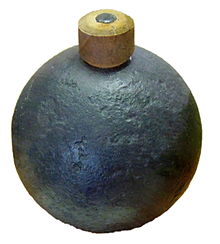
A bomb is an
The term bomb is not usually applied to explosive devices used for
The word comes from the
term meaning 'booming', 'buzzing'.History
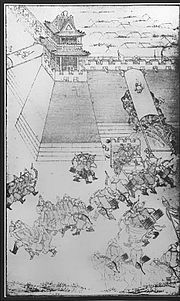
Gunpowder bombs had been mentioned since the 11th century. In 1000 AD, a soldier by the name of Tang Fu (唐福) demonstrated a design of gunpowder pots (a proto-bomb which spews fire) and gunpowder caltrops, for which he was richly rewarded.[6] In the same year, Xu Dong wrote that trebuchets used bombs that were like "flying fire", suggesting that they were incendiaries.[7] In the military text Wujing Zongyao of 1044, bombs such as the "ten-thousand fire flying sand magic bomb", "burning heaven fierce fire unstoppable bomb", and "thunderclap bomb" (pilipao) were mentioned. However these were soft-shell bombs and did not use metal casings.[8][9]
Bombs made of cast iron shells packed with explosive gunpowder date to 13th century China.[10] Explosive bombs were used in East Asia in 1221, by a Jurchen Jin army against a Chinese Song city.[2] The term for this explosive bomb seems to have been coined the "thunder crash bomb" during a Jin dynasty (1115–1234) naval battle in 1231 against the Mongols.[10]
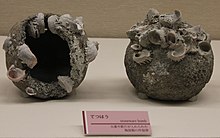
The History of Jin (金史) (compiled by 1345) states that in 1232, as the Mongol general Subutai (1176–1248) descended on the Jin stronghold of Kaifeng, the defenders had a "thunder crash bomb" which "consisted of gunpowder put into an iron container ... then when the fuse was lit (and the projectile shot off) there was a great explosion the noise whereof was like thunder, audible for more than thirty miles, and the vegetation was scorched and blasted by the heat over an area of more than half a mou. When hit, even iron armour was quite pierced through."[10]
The Song Dynasty (960–1279) official Li Zengbo wrote in 1257 that
During the Mongol invasions of Japan, the Mongols used the explosive "thunder-crash bombs" against the Japanese. Archaeological evidence of the "thunder-crash bombs" has been discovered in an underwater shipwreck off the shore of Japan by the Kyushu Okinawa Society for Underwater Archaeology. X-rays by Japanese scientists of the excavated shells confirmed that they contained gunpowder.[11]
Shock
Explosive shock waves can cause situations such as body displacement (i.e., people being thrown through the air), dismemberment, internal bleeding and ruptured eardrums.[12]
Shock waves produced by explosive events have two distinct components, the positive and negative wave. The positive wave shoves outward from the point of detonation, followed by the trailing vacuum space "sucking back" towards the point of origin as the shock bubble collapses. The greatest defense against shock injuries is distance from the source of shock.[13] As a point of reference, the overpressure at the Oklahoma City bombing was estimated in the range of 28 MPa.[14]
Heat
A thermal wave is created by the sudden release of heat caused by an explosion. Military bomb tests have documented temperatures of up to 2,480 °C (4,500 °F). While capable of inflicting severe to catastrophic burns and causing secondary fires, thermal wave effects are considered very limited in range compared to shock and fragmentation. This rule has been challenged, however, by military development of thermobaric weapons, which employ a combination of negative shock wave effects and extreme temperature to incinerate objects within the blast radius.
Fragmentation
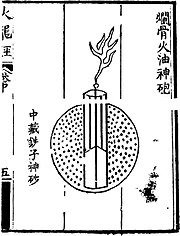
While conventionally viewed as small metal shards moving at super-
Effects on living things
To people who are close to a blast incident, such as bomb disposal technicians, soldiers wearing body armor, deminers, or individuals wearing little to no protection, there are four types of blast effects on the human body:
Types



Experts commonly distinguish between civilian and military bombs. The latter are almost always mass-produced weapons, developed and constructed to a standard design out of standard components and intended to be deployed in a standard explosive device.
Improvised explosive materials are typically unstable and subject to spontaneous, unintentional detonation triggered by a wide range of environmental effects, ranging from
Atomic bombs are based on the theory of
The term "
The power of large bombs is typically measured in
Below is a list of five different types of bombs based on the fundamental explosive mechanism they employ.
Compressed gas
Relatively small explosions can be produced by pressurizing a container until catastrophic failure such as with a dry ice bomb. Technically, devices that create explosions of this type can not be classified as "bombs" by the definition presented at the top of this article. However, the explosions created by these devices can cause property damage, injury, or death. Flammable liquids, gasses and gas mixtures dispersed in these explosions may also ignite if exposed to a spark or flame.
Low explosive
The simplest and oldest bombs store energy in the form of a
High explosive
A high explosive bomb is one that employs a process called "
Thermobaric
A
Nuclear fission
Nuclear fission type atomic bombs utilize the energy present in very heavy atomic nuclei, such as U-235 or Pu-239. In order to release this energy rapidly, a certain amount of the fissile material must be very rapidly consolidated while being exposed to a neutron source. If consolidation occurs slowly, repulsive forces drive the material apart before a significant explosion can occur. Under the right circumstances, rapid consolidation can provoke a chain reaction that can proliferate and intensify by many orders of magnitude within microseconds. The energy released by a nuclear fission bomb may be tens of thousands of times greater than a chemical bomb of the same mass.
Nuclear fusion
A thermonuclear weapon is a type of nuclear bomb that releases energy through the combination of fission and fusion of the light atomic nuclei of deuterium and tritium. With this type of bomb, a thermonuclear detonation is triggered by the detonation of a fission type nuclear bomb contained within a material containing high concentrations of deuterium and tritium. Weapon yield is typically increased with a tamper that increases the duration and intensity of the reaction through inertial confinement and neutron reflection. Nuclear fusion bombs can have arbitrarily high yields making them hundreds or thousands of times more powerful than nuclear fission.
A pure fusion weapon is a hypothetical nuclear weapon that does not require a primary fission stage to start a fusion reaction.
Antimatter
Antimatter bombs can theoretically be constructed, but antimatter is very costly to produce and hard to store safely.
Other
- Aerial bomb – designed to be dropped from a military aircraft (or even any aircraft) and carried on hardpoints or in bomb bays
- Delay-action bomb – explodes some time after impact, as opposed to before or on impact
- Dummy bomb – harmless bomb that has been fully disabled or has had its explosive contents removed, often used for training or display
- Glide bomb – features flight control surfaces, allowing it to glide fairly long distances to its target
- General-purpose bomb – aerial bomb dropped for multiple purposes, and thus designed to suit multiple purposes
- Incendiary bomb – designed to set targets ablaze
- Cluster bomb – releases additional submunitions, often smaller bombs, upon detonation
- Anti-runway penetration bomb – designed to destroy runways and aprons
- Bunker buster – capable of penetrating hardened or fortified surfaces before detonating
- Concrete bomb – contains dense, inert material (typically concrete) instead of explosives, using the kinetic energy of the falling bomb to destroy target
- Improvised explosive device – classification of bombs produced in unconventional ways or using unconventional materials; includes explosives such as the barrel bomb, nail bomb, pipe bomb, pressure cooker bomb, fertilizer bomb, and Molotov cocktail
Delivery
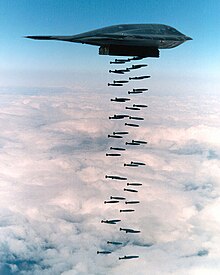

The
The first bombing from a fixed-wing aircraft took place in 1911 when the Italians dropped bombs by hand on the Turkish lines in what is now Libya, during the Italo-Turkish War.[20] The first large scale dropping of bombs took place during World War I starting in 1915 with the German Zeppelin airship raids on London, England, and the same war saw the invention of the first heavy bombers. One Zeppelin raid on 8 September 1915 dropped 4,000 lb (1,800 kg) of high explosives and incendiary bombs, including one bomb that weighed 600 lb (270 kg).[21]
During World War II bombing became a major military feature, and a number of novel delivery methods were introduced. These included Barnes Wallis's bouncing bomb, designed to bounce across water, avoiding torpedo nets and other underwater defenses, until it reached a dam, ship, or other destination, where it would sink and explode. By the end of the war, planes such as the allied forces' Avro Lancaster were delivering with 50 yd (46 m) accuracy from 20,000 ft (6,100 m), ten ton earthquake bombs (also invented by Barnes Wallis) named "Grand Slam", which, unusually for the time, were delivered from high altitude in order to gain high speed, and would, upon impact, penetrate and explode deep underground ("camouflet"), causing massive caverns or craters, and affecting targets too large or difficult to be affected by other types of bomb.
Modern military
Aircraft may also deliver bombs in the form of warheads on guided missiles, such as long-range cruise missiles, which can also be launched from warships.
A
A bomb may also be positioned in advance and concealed.
A bomb destroying a
, and, to a lesser extent (depending on circumstances), to roads.In the case of
The Blue Peacock nuclear mines, which were also termed "bombs", were planned to be positioned during wartime and be constructed such that, if disturbed, they would explode within ten seconds.
The explosion of a bomb may be triggered by a
Blast seat
In forensic science, the point of detonation of a bomb is referred to as its blast seat, seat of explosion, blast hole or epicenter. Depending on the type, quantity and placement of explosives, the blast seat may be either spread out or concentrated (i.e., an explosion crater).[23]
Other types of
See also
References
- ISBN 978-1-58765-423-7.
- ^ ISBN 978-1-57958-116-9.
- ^ βόμβος Archived 2013-11-07 at the Wayback Machine, Henry George Liddell, Robert Scott, A Greek-English Lexicon, on Perseus
- ^ ISBN 978-0-521-30358-3. Archivedfrom the original on 2016-08-26.
- ISBN 978-0-521-30358-3. Archivedfrom the original on 2016-08-26.
- ^ Andrade 2016, p. 32.
- ^ Needham 1986, p. 148.
- ^ Andrade 2016, p. 16.
- ^ Needham 1986, p. 169.
- ^ a b c d Needham, Joseph. (1987). Science and Civilization in China: Volume 5, Chemistry and Chemical Technology, Part 7, Military Technology; the Gunpowder Epic. Cambridge University Press. pp. 170–174.
- ^ Delgado, James (February 2003). "Relics of the Kamikaze". Archaeology. 56 (1). Archaeological Institute of America. Archived from the original on 2013-12-29.
- ISBN 978-1-58765-423-7.
- ISBN 1-932235-00-0.
- ^ Wong, Henry (2002). "Blast-Resistant Building Design Technology Analysis of its Application to Modern Hotel Design". WGA Wong Gregerson Architects, Inc. p. 5.
- ISBN 978-0-521-30358-3. Archivedfrom the original on 2016-08-26.
- ^ Coupland, R.M. (1989). Amputation for antipersonnel mine injuries of the leg: preservation of the tibial stump using a medial gastrocnemius myoplasty. Annals of the Royal College of Surgeons of England. 71, pp. 405–408.
- ^ Solovyov, Dmitry (2007-09-12). "Russia tests superstrength bomb, military says". Reuters. Archived from the original on 2008-04-19. Retrieved 2008-06-02.
- ^ "Ring Strain in Cycloalkanes". Orgo Made Simple. Archived from the original on 22 June 2015. Retrieved 22 June 2015.
- ISBN 1-85109-488-1. Retrieved 2008-05-26.
- ISBN 0-9712546-0-5. Retrieved 2008-05-26.
- ^ Wilbur Cross, "Zeppelins of World War I" page 35, published 1991 Paragon House ISBN I-56619-390-7
- ^ Jackson, S.B. (June 1968). The Retardation of Weapons for Low Altitude Bombing (Report). United States Naval Institute Proceedings.
- ^ ISBN 978-1-58765-423-7.
Bibliography
- Andrade, Tonio (2016), The Gunpowder Age: China, Military Innovation, and the Rise of the West in World History, Princeton University Press, ISBN 978-0-691-13597-7.
External links
- Explosive Violence, The Problem of Explosive Weapons A report by Richard Moyes (Landmine Action, 2009) on the humanitarian problems caused by the use of bombs and other explosive weapons in populated areas
- FAS.org Bombs for Beginners
- MakeItLouder.com How a bomb functions and rating their power
